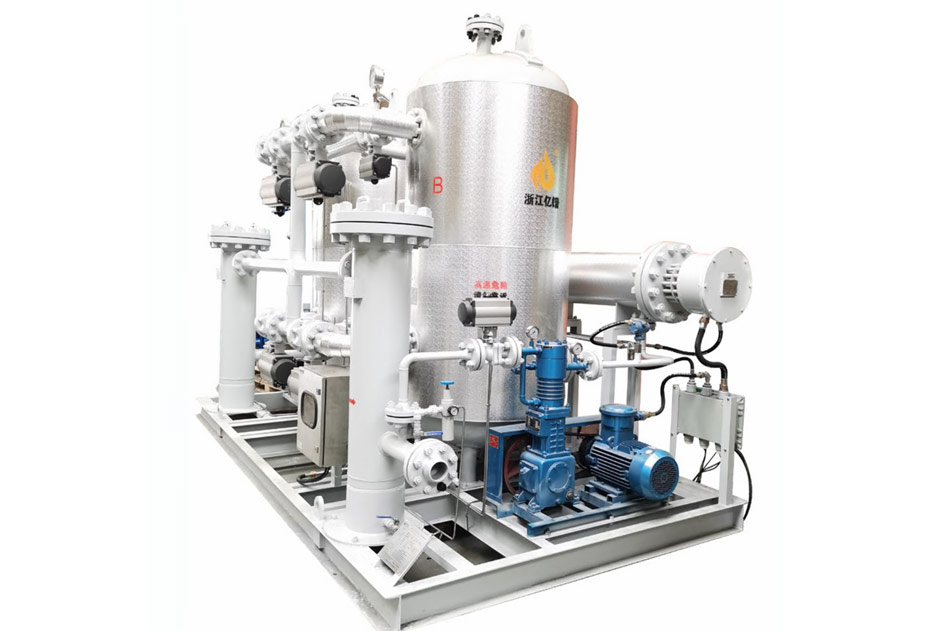Compressed Air Drying Solutions for the Chemical Industry
Industry Pain Points
High Corrosion Risk: Chemical compressed air contains acidic gases (e.g., H₂S, SO₂) and organic solvent vapors, causing corrosion and perforation of traditional drying equipment, with an average service life of less than 3 years.
Severe Oil-Water Pollution: The exhaust of screw compressors contains 5-50ppm oil and saturated moisture (dew point +40℃), which pollutes precision instruments and reaction kettles, resulting in annual losses of over 2 million yuan per production line.
High Energy Consumption: The regeneration energy consumption of traditional adsorption dryers ranges from 0.15-0.3kWh/Nm³, accounting for over 25% of the total power consumption of the air compression system.
Safety Compliance Pressure: Equipment in chemical explosion-proof areas is required to meet ATEX/IECEx standards, and the cost of explosion-proof modification for existing drying systems increases by 40%.
System Overview
Through the “anti-corrosion pretreatment – deep dehumidification – heat recovery regeneration” technology chain, Yipu Chemical Compressed Air Drying System achieves:
- Intrinsic Safety: Fully meets chemical explosion-proof requirements from materials to control systems.
- Ultra-Low Energy Consumption: Comprehensive energy efficiency is 60% higher than industry standards.
- Zero Pollution: Synchronous removal of oil, water, and VOCs, with emissions exceeding the requirements of GB 16297 (Emission Standard for Air Pollutants).
Solution Approach
Yipu Chemical Industry Compressed Air Drying Solution
| Module | Technical Highlights | Performance Indicators |
|---|---|---|
| Anti-Corrosion Separator | PTFE lining + 316L shell, resistant to H₂S ≤500ppm | Liquid droplet removal rate ≥99.9% |
| Low-Temperature Refrigerated Dryer | Perfluoroether rubber sealing, anti-solvent penetration | Dew point +3℃, COP ≥3.0 |
| Explosion-Proof Adsorption Tower | Carbon fiber winding, Ex dⅡCT4 certification | Outlet dew point -40℃, oil poisoning resistance service life of 5 years |
| Heat Recovery System | Plate heat exchanger recovers waste heat from air compressors | Regeneration energy consumption ≤0.03kWh/Nm³ |
| Intelligent Control | SIL3-level safety PLC, automatic tower switching when VOCs concentration exceeds standards | Response time ≤1 second |
Applicable Scenarios:
- Instrument air in petrochemical explosion-proof areas
- Sterile compressed air for pharmaceutical industry
- Electronic specialty gas transmission systems
- Powder coating drying in the coating industry
Technical Principles
Yipu Four-Stage Deep Purification Process:
- Anti-Corrosion Pretreatment (Stage 1):PTFE-coated cyclone separators remove 99% of liquid oil and water, and are resistant to strong corrosion with pH 1-14.
- Condensation Dehumidification (Stage 2):Freon direct expansion refrigeration cools the air from 40℃ to 3℃, reducing the dew point to +3℃.
- Composite Adsorption (Stage 3):Activated carbon – molecular sieve double-layer bed:
- Activated carbon adsorbs oil mist (residual oil ≤0.001ppm)
- 4A-AC molecular sieves achieve deep dehydration to -40℃
- Waste Heat Regeneration (Stage 4):Recovers waste heat from air compressors (70-90℃) to drive regeneration, saving 80% more energy than electric heating.
Core Advantage
| Advantage | Details |
|---|---|
| Customized on Demand | Meets special working conditions; provides professional non-standard customization |
| Low Cost | Adopts cyclic regeneration process; significantly reduces operating costs |
| High Stability | Dual-tower structure with small pressure fluctuation; low noise and continuous gas supply |
| Fully Automatic Operation | Easy to operate, reducing labor input; improves efficiency |
| High Safety | Presets multi-level safety protection measures; supports automatic alarm |
| Low Failure Rate | Maintains low failure rate after 10,000 hours; high durability with almost no maintenance required |
Technical Strength
Leading Adsorption Dehydration Technology
Uses high-performance molecular sieve adsorbents with high water absorption capacity and resistance to corrosion by acidic gases (H₂S/CO₂), ensuring deep dehydration with a dew point ≤-70℃.
The original hot nitrogen regeneration process reduces energy consumption by 30% compared with traditional electric heating regeneration, and integrates a waste heat recovery system to significantly improve energy efficiency.
Modular and Customized Design Capability
Core equipment adopts modular prefabrication, supporting rapid deployment (installation cycle shortened by 50%) and adapting to diverse scenarios such as offshore platforms, onshore gas fields, and LNG pretreatment.
Can customize single-tower, dual-tower, or multi-tower parallel systems according to customer needs, with a treatment capacity ranging from 10,000 to 1,000,000 Nm³/d, flexibly matching gas fields of different scales.
Intelligent Control and Remote Operation & Maintenance
Equipped with a PLC+IoT intelligent control system, it real-time monitors key parameters such as pressure, temperature, and dew point, supporting fault early warning and automatic adjustment.
Through cloud-based big data analysis, it optimizes the adsorption-regeneration cycle, extends the service life of molecular sieves, and reduces operation and maintenance (O&M) costs by 10%-15%.
Energy-Saving and Environmental Protection Technology
Features zero-emission design for regeneration exhaust gas, complying with international environmental standards such as EU CE and US EPA.
Energy consumption is 25%-40% lower than that of traditional triethylene glycol (TEG) dehydration systems, helping customers achieve carbon emission reduction goals.
Long-Cycle Operation Reliability
Molecular sieves adopt anti-pulverization coating technology, with a service life of over 5 years, reducing replacement frequency.
Key components (e.g., valves, instruments) are selected from international first-tier brands (e.g., Siemens, Emerson), with a Mean Time Between Failures (MTBF) of over 100,000 hours.
Strong R&D and Engineering Experience
Possesses more than 19 patents and software copyrights in dehydration technology; the R&D team is led by doctors and has in-depth cooperation with universities and colleges.
Has over 1,000 successful cases worldwide, covering extreme working conditions such as high-sulfur gas fields in the Middle East and low-temperature environments in the Arctic.
Product Advantage Comparison
| Indicator | Yipu System | TEG Dehydration | Refrigeration Method | Competitor Adsorption Systems |
|---|---|---|---|---|
| Dew Point | -40℃ (customizable to -70℃) | -40℃ (high energy consumption) | +3℃ | -20℃ (requires pre-installed refrigerated dryer) |
| Residual Oil Content | ≤0.001ppm | ≤0.01ppm | ≤1ppm | ≤0.005ppm |
| Explosion-Proof Rating | Ex dⅡCT4 (full series) | Requires additional modification | Not applicable | Ex ibⅡCT4 |
| Energy Consumption | 0.1kWh/Nm³ (comprehensive) | 0.25kWh/Nm³ | 0.08kWh/Nm³ | 0.15kWh/Nm³ |
| Service Life | 10 years (key components) | 5 years (requires adsorbent replacement) | 8 years | 6 years |
Typical Case
Project Name: East China Base of a Multinational Chemical Group
Operating Conditions:
- Treatment Capacity: 3000 Nm³/h, containing 300ppm H₂S and 20ppm oil mist
- Explosion-Proof Requirement: Zone 1, SIL3 safety level
Dehydration Effect:
- Dew point stably reduced from +40℃ to -45℃
- Instrument failure rate decreased by 90%
Economic Benefits:
- Annual electricity cost savings of 2.8 million yuan
- Reduced waste catalyst losses by 5 million yuan per year

